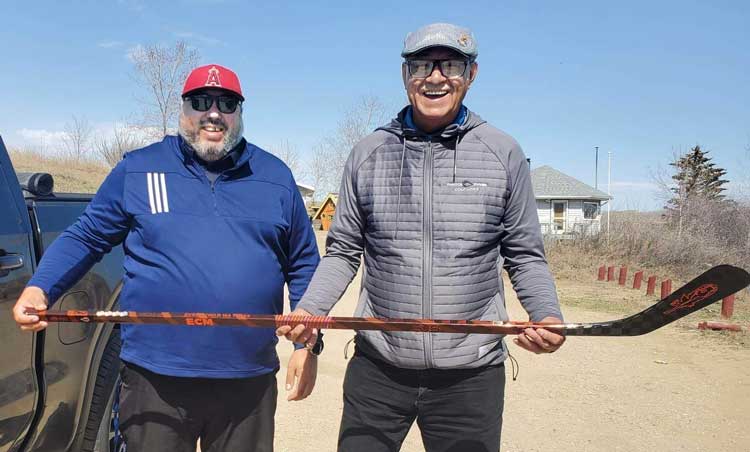
When hockey players of all ages take a shot on net next season, they could find themselves scoring in the name of truth and reconciliation.
Recently Clay DeBray, manager of Snipe and Celly Sports Excellence on Flying Dust First Nation, designed a special hockey stick, one he hopes will be utilized not only as a tool of the game, but also as a tool to encourage conversations about residential schools and the importance of truth and reconciliation.
“I was sitting in my office one day taking orders for numerous orange T-shirts – there’s an organization planning for Sept. 30 already,” DeBray explained. “It then came across my mind, while I strongly believe in the orange shirt movement, a lot of people only wear an orange shirt on Sept. 30 rather than having it in their weekly T-shirt drawer. I was looking for a way to bring awareness and education to the dark era of residential schools, and that’s when I thought of designing a hockey stick.”
DeBray began to doodle some ideas on his notepad, drawing up different hockey sticks and, once he came up with one he liked, he contacted Sports Excellence headquarters to see if they would support such an initiative.
“They were 100 per cent behind it, so I followed protocol by bringing in an elder, Eugene Arcand of Muskeg Lake First Nation, who has been an advisor and mentor to me for a long time,” DeBray said.
Arcand is featured on 781: A Story of Sports and Survival in Canadian Residential School, a five-part written series featured on TSN’s website. DeBray felt, because Arcand’s story is tied so much to the world of hockey, he would be ideal to bring in to assist him with the hockey stick project.
“The design of the stick came from me, but Eugene is there to walk alongside me,” DeBray said. “I’m very thankful for him. I have such great insight and input on the protocol we have to follow in our Indigenous culture, and having him beside me, well, he gives me that self-confidence about this being an amazing project we’re doing. Eugene and I did presentations to all the Sports Excellence owners across Canada. The stick will be available in all Sports Excellence stores while we will be the hub here.”
The stick features several images including a teddy bear to represent how children in residential schools were not allowed to have the things they would normally use for comfort, a turtle with medicine wheel to represent how everyone lives on Turtle Island and the need to live a holistic lifestyle, the Métis sash because Métis children also attended residential school, hands of different skin tones to represent the need of every race to give a helping hand toward raising awareness, a teardrop to represent how children could not cry without being punished and a feather to represent the eagle and its meaning to First Nations culture.
“The toughest part of this entire project is time constraints,” DeBray added.
The first order of sticks needed to be in by May 15 because it takes 45 days to produce the stick and 45 days on the boat to come across to Canada.
“This means our first order should arrive in early December, so we can disperse it to individuals or teams by the Sept. 30 reconciliation game,” DeBray noted. “More than likely we’ll do a second order in late July so the sticks can arrive by Christmas. Sept. 30 is the day we recognize, but we want these sticks used every day in the game of hockey to promote education and awareness.”
The cost for a senior stick is $199 while junior sticks sell for $159. Orders can be placed by contacting DeBray via email at claydebray@hotmail.com or via social media. Proceeds will go to the National Truth and Reconciliation Centre in Winnipeg, the National Orange Shirt Society and the Saskatoon Survivors Circle.
“I have a list comprised here of a bunch of names already – people from B.C. all the way to the Maritimes who want one,” DeBray said. “A lot of people are loving the idea of this. We’ve even had some chats with people involved with the NHL, junior hockey teams and more. I will admit, when they sent me the first prototype of the stick and I held it in my hands, it was emotional. It was emotional because this is another tool we can utilize in a small way or a big way to keep the awareness going. That’s what it’s all about. It’s not about the profits, it’s a small way to get it out there and have that conversation going.”
DeBray also stressed how this will be a playable stick.
“It can be used,” he said. “It’s not just a stick to hang on your wall as a souvenir. You can do that, but I wanted it to be a playable stick. This will be a high-end stick, similar to the Bauers and CCMs out there. It will allow players from kids to adults to use this stick every practice and in every game throughout the hockey season, and to bring that awareness and to start conversations about truth and reconciliation… Truth and reconciliation is not just about one day a year. I believe things are getting better, but we still have a long way to go. We just need to continue to educate our society as a whole on what the truths are about Canada’s dark era. I went to residential school, but was fortunate enough the abuse and atrocities didn’t happen to me. I’m very thankful for that, but, now, there’s a place in my heart where I feel for all our residential school survivors. This is just a small way for myself to initiate something, to bring that education and awareness forward.”
by Phil Ambroziak